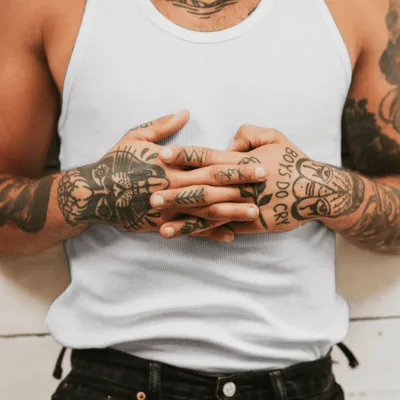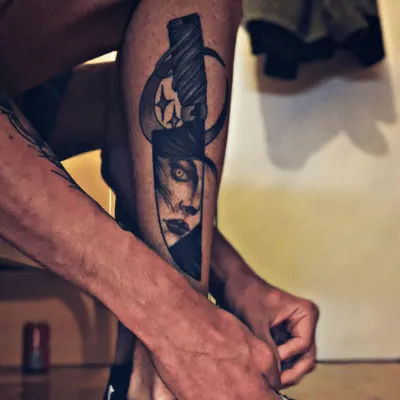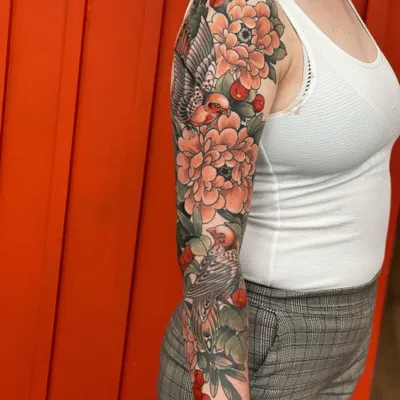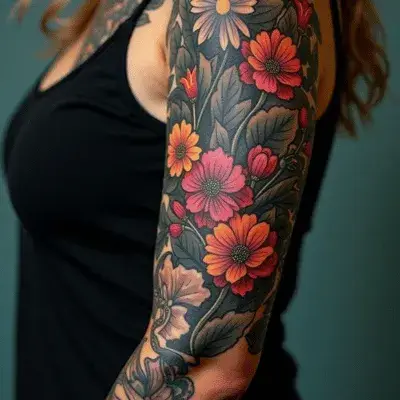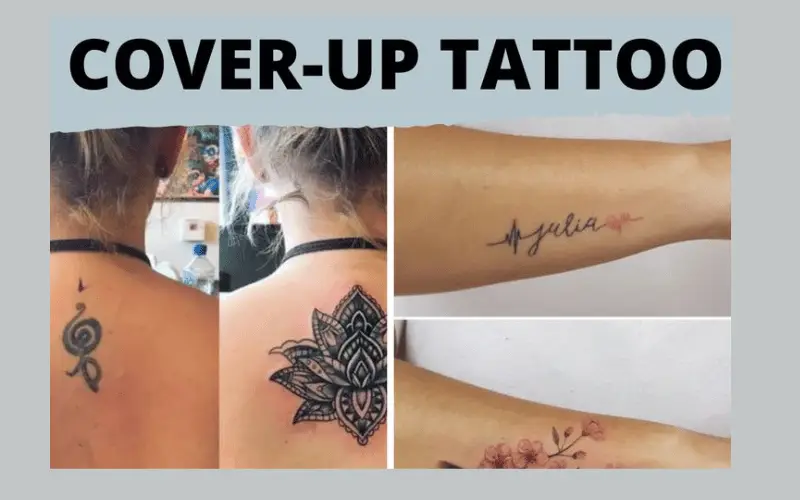We’ve all been there. Maybe it’s that impulsive butterfly you got on spring break, your ex’s name (big yikes!), or just a piece that doesn’t reflect who you are anymore. Whatever your reason for wanting to hide your ink—whether temporarily for a job interview or permanently with new art—I’ve got you covered with solutions for every situation!
This guide breaks down all your tattoo-concealing options, from quick makeup fixes to professional cover-up designs that’ll make you forget the original was ever there. Let’s transform that tattoo regret into something you’ll love!
Temporary Cover-Up Solutions
Need to hide your tattoo just for today? Here are your best temporary options:

Makeup Magic: Conceal Like a Pro
Standard makeup might work for tiny tattoos, but for real coverage, you’ll need specialized products:
The Ultimate Tattoo-Covering Makeup Kit
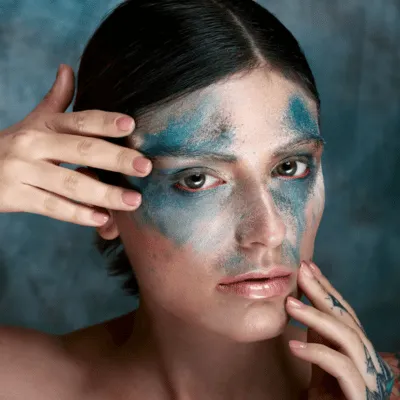
For best results, gather these essential items:
- Color corrector (orange/salmon tones work best to neutralize blue/black ink)
- High-coverage foundation several shades lighter than your skin tone
- Full-coverage concealer that matches your skin exactly
- Setting powder (translucent or matching your skin tone)
- Setting spray to make it all stay put
- Makeup sponges for seamless application
Step-by-Step Tattoo Concealing Process

- Clean and prep the area – Wash with soap and water, pat dry, and apply a thin layer of moisturizer (let it fully absorb)
- Color correct – Dab orange/salmon color corrector over the tattoo using a makeup sponge. This counteracts the blue/black undertones in most tattoos. Build in thin layers rather than one thick coat.
- Foundation layer – Apply a lighter foundation over the color corrector, extending slightly beyond the tattoo edges to blend seamlessly.
- Concealer precision – Use skin-matching concealer to perfect the coverage, focusing on any spots where the tattoo still shows through.
- Set and seal – Dust setting powder generously over the area, then spritz with setting spray and allow to dry completely.
- Final touch-ups – Once dry, check in natural lighting and add more concealer if needed.
Pro Tips for Makeup Longevity
- Apply in thin layers rather than thick globs
- Pat products on instead of rubbing or swiping
- Avoid touching the covered area
- Carry powder for touch-ups throughout the day
- For body parts that bend (wrists, elbows), flex the area while applying products
Specialized Tattoo Cover Products
For serious coverage (especially for darker tattoos), these dedicated products outperform regular makeup:
- Dermablend Professional Cover Creme – The gold standard for professional-grade coverage
- Kat Von D Lock-It Concealer – Ironically made by a tattoo artist, but works amazingly!
- Make Up For Ever Full Cover Concealer – Waterproof and highly pigmented
- Tattoo Camo – Specifically designed for covering body art
Clothing and Accessories: The Simplest Solution

Sometimes the easiest option is to just cover up with:
- Compression sleeves – Available in various skin tones, these provide full arm coverage
- Wristbands – Perfect for small wrist tattoos
- Temporary tattoo bandages – Skin-colored patches designed specifically for covering tattoos
- Strategic clothing choices – Long sleeves, high necklines, etc.
- Jewelry – Chunky bracelets or watches can hide smaller pieces
Permanent Cover-Up Solutions
When you’re ready for a more lasting solution, you’ve got options beyond just laser removal:
Cover-Up Tattoos: Transforming Old Art Into New

A skilled tattoo artist can incorporate your existing tattoo into a new design. This isn’t just slapping something on top—it’s artistic transformation!
What Makes a Good Cover-Up Candidate?
Some tattoos are easier to cover than others:
- Faded tattoos cover much more easily than fresh, dark ink
- Simple designs with minimal detail are easier to work with
- Black/gray tattoos are generally easier to cover than colorful ones
- Smaller pieces obviously offer more options than larger ones
Cover-Up Design Strategies That Work

Smart artists use these techniques to hide original tattoos:
- Working with (not against) the old tattoo – Incorporating elements of the original into the new design
- Strategic color choices – Using darker colors to obscure existing ink
- Texture and detail – Adding complexity to distract from the original design
- Size expansion – Making the new piece larger to provide context for the original elements
Popular Cover-Up Design Styles
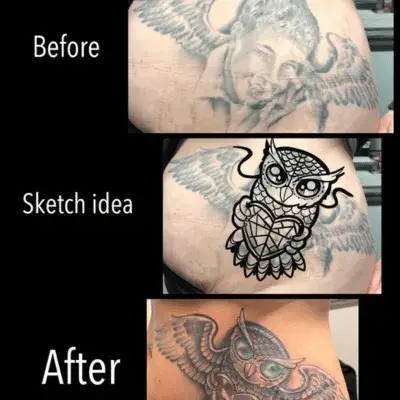
These tattoo styles tend to work particularly well for cover-ups:
- Neo-traditional – Bold outlines and saturated colors help conceal old ink
- Black and gray realism – Shadowy details can effectively disguise older work
- Blackwork/Geometric – Solid areas of black ink can completely obscure previous tattoos
- Japanese traditional – Dense, colorful elements with black backgrounds excel at coverage
- Floral designs – Organic shapes and varied textures can effectively incorporate odd shapes
The Cover-Up Consultation Process
When meeting with an artist about a cover-up:
- Be upfront about your goals – Show the tattoo clearly and explain what bothers you about it
- Listen to their expertise – If they say it won’t work, believe them
- Consider a partial removal first – Sometimes 1-2 laser sessions before a cover-up creates better results
- Be realistic about size – Expect your new tattoo to be larger than the original
- Discuss color limitations – Understand that your options might be restricted by the original ink
Finding the Right Cover-Up Artist
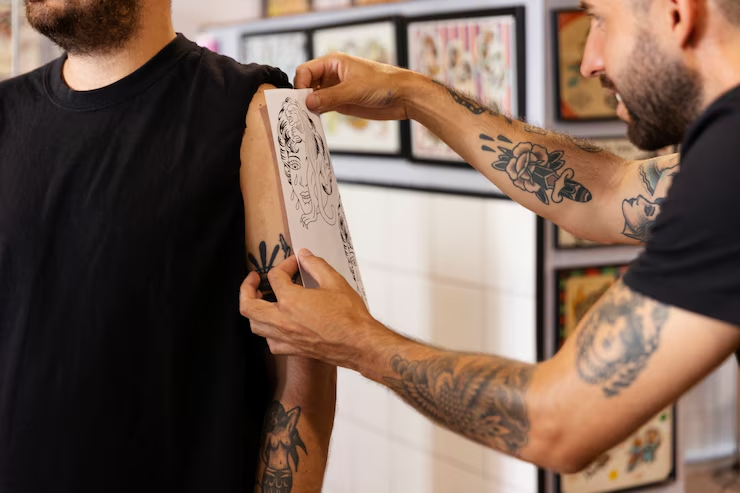
Not all tattoo artists specialize in cover-ups. Look for:
- Portfolios with before/after cover-up examples
- Artists who specifically mention cover-ups in their bio
- Experience with the style you’re interested in
- Patience and willingness to explain their approach
Laser Tattoo Removal: The Nuclear Option
Sometimes the best cover-up is no tattoo at all. Laser removal can either completely eliminate your tattoo or fade it enough for a better cover-up:
How Laser Removal Works
- Specialized lasers break down ink particles into tiny fragments
- Your immune system gradually removes these fragments from your body
- Multiple sessions are typically required (often 6-12)
- Sessions are usually spaced 6-8 weeks apart
What to Expect During Laser Removal
Let’s be honest about the process:
- Pain level – Most people find it more painful than getting the tattoo (like hot grease splatter or rubber band snaps)
- Recovery – Expect blistering, scabbing, and redness between sessions
- Results timeline – Complete removal can take 1-2 years of treatments
- Cost – Typically $200-500 per session depending on size and location
Is Your Tattoo a Good Laser Candidate?
Certain factors affect removal success:
- Age of tattoo – Older tattoos are often easier to remove
- Ink colors – Black and dark blue respond best; yellow, white, and green are more stubborn
- Skin tone – Removal is generally easier on fair skin
- Tattoo location – Areas with good circulation (closer to heart) clear faster
- Amateur vs. professional – Homemade tattoos are often easier to remove
Partial Removal for Better Cover-Ups
Many people choose a hybrid approach:
- Get 2-4 laser sessions to fade the tattoo
- Once significantly lightened, have a cover-up tattoo done
- This approach gives your artist more options and often yields better results
Specialty Solutions for Specific Situations
Different scenarios might call for different approaches:
For Job Interviews & Professional Settings
When you need to look “tattoo-free” in a conservative workplace:
- Professional airbrushing – For one-day perfect coverage, consider professional body makeup services
- Full-coverage foundation with setting spray designed for hot stage lights
- Strategic interview outfits that naturally cover tattoo areas
For Weddings & Special Events

When your fancy outfit conflicts with your ink:
- Bridal makeup artists often specialize in body coverage (book a trial run!)
- Waterproof, sweat-proof products are essential for emotional, potentially sweaty occasions
- Photography considerations – Some tattoos that seem covered in person may show through in professional photos
For Swimming & Beach Days
Waterproof options for fun in the sun:
- Waterproof body makeup – Products like Dermablend’s leg and body cover with setting powder can survive swimming
- Water-resistant sleeves – Specialized compression garments designed for aquatic activities
- Temporary cover patches – Waterproof adhesive covers designed for swimming
The Psychological Side of Covering Tattoos
It’s not just about the physical coverage:
Coming to Terms with Tattoo Regret
- Recognize that tastes and identity evolve—it’s normal to outgrow earlier choices
- Consider whether covering/removing is what YOU want or what others expect
- Remember that regret doesn’t mean you made a “mistake”—it was right for you then, and changing it is right for you now
The Transformation Experience
Many people find unexpected emotional benefits in the cover-up process:
- The symbolic act of transforming something unwanted into something beautiful
- Reclaiming control over your body image
- Creating meaningful closure to a past chapter
DIY vs. Professional Approaches
When to handle it yourself and when to call in the experts:
When DIY Works Best
- Quick, one-day coverage for small tattoos
- Basic concealing for light, faded ink
- Temporary solutions for non-critical events
When to Hire Professionals
- Important events like weddings or job interviews
- Large or very dark tattoos
- When you need coverage to last all day/night
- When water/sweat resistance is critical
The Bottom Line
Whether you’re looking for a quick fix for tomorrow’s job interview or a permanent solution to tattoo regret, you’ve got options! From makeup magic to artistic transformations, there’s a covering strategy that will work for your specific situation and budget.
Remember that tattoos—whether getting them, covering them, or removing them—are part of your personal journey. There’s no shame in changing course when a particular piece no longer serves you.
Have you successfully covered or transformed a tattoo you regretted? Share your experience in the comments!

